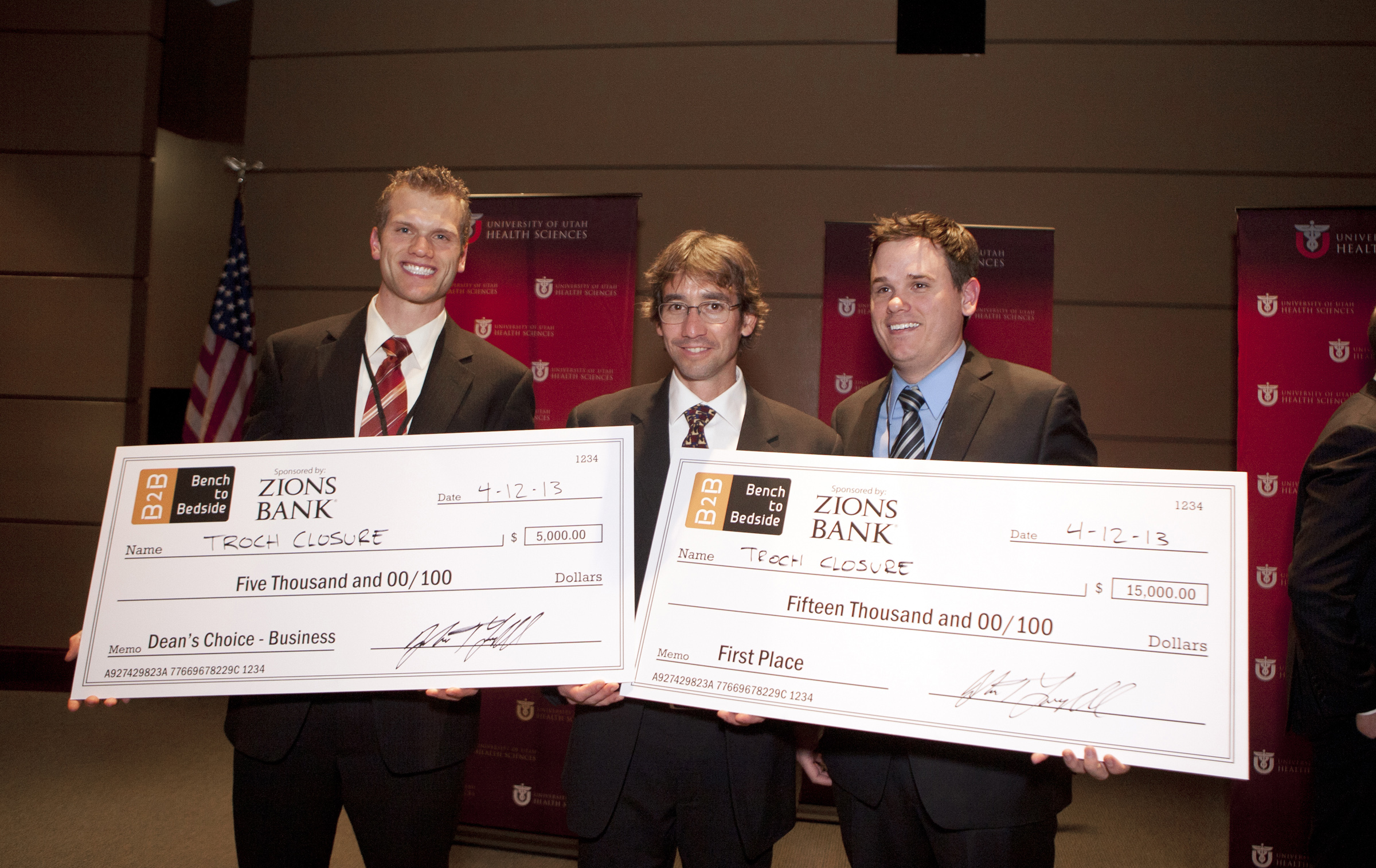
April 17, 2013 — Teddy bears, mechanical leeches, brain drill bits and many more prototypes are not things you would expect to see at a typical student competition. But the annual Bench-2-Bedside competition at the University of Utah is anything but typical.
Bench-2-Bedside is a medical-device prototype and business-plan competition that just concluded its third season. Eighteen teams competed, and the top teams won more than $70,000 in cash and prizes to develop their ideas. Teams consisted of students from across campus – including medical, engineering and business students. Each team begins with only $500 and an idea. In six months, they create a working prototype and solid business plan.
“This program represents a paradigm shift in the way we educate tomorrow’s doctors, engineers and business leaders,” says John Langell, M.D., Ph.D., M.P.H., a surgeon and the director of the U’s Center for Medical Innovation, the parent organization for Bench-2-Bedside. “Instead of learning in a classroom, these students learn by forming interdisciplinary teams that create devices with real potential.”
Team Troclosure won the Grand Prize of $15,000, in addition to the $5,000 prize for Best Business Idea. The team invented a device to help surgeons suture the inside of the hole created when doing laparoscopic surgery. The device simplifies a process that usually requires extra time and equipment when a surgeon works through a small hole to secure a suture inside the abdominal wall. This device would have benefited an estimated 2.5 million patients who received laparoscopic surgery in the U.S. in 2012.
“They actually have something that is ready to license soon,” Langell says. “As a surgeon, this is something I want to use. This is a problem every day.”
Team Troclusure consists of bioengineering students Pablo Johnson, Mike Fogarty and Spencer Madsen. They used the experience to improve their understanding of how medical devices are invented and launched – however, they are also serious about selling their device. The team has already filed a patent, and they are hopeful they can license the technology to an established company.
The team plans to use the $20,000 they won to create a professional prototype – something more refined than the 3D printing they used for the competition – with the ultimate goal of making progress toward animal trials and approval from the Food and Drug Administration.
“It’s going to decrease complications for patients, it’s going to decrease operating-room time, and it’s going to keep surgeons from sticking themselves with needles,” says Johnson, who is also a medical student.
Other award winners had equally interesting prototypes, such as:
- TeddyCare won $5,000 for the new Engineering Arts and Entertainment Award. The new award hopes to promote interactive design and gaming. The team is developing multiple devices, including a teddy bear that can collect and transmit pulse-oximetry, thermometer and baby-monitor data to smartphones and other devices.
- Team Mechanical Leech was one of three runner-up teams that won $10,000. They developed a prototype that can replace live leeches to remove old, black blood with fresh, oxygenated blood during surgical procedures.
- Team HEAD Bit won $5,000 for the Best Engineering Award. HEAD stands for helical epidural access drill bit. They have a drill bit that minimizes tissue damage and increases cutting efficiency during brain surgeries.
Winning teams use the money to develop their devices, so Bench-2-Bedside is just the beginning for them, and any other team that wants to go beyond the prototype stage.
“Your dream doesn’t have to end here even if you didn’t win a big check,” says Matthew Sorensen, a medical student at the U and president of Bench-2-Bedside.
Bench-2-Bedside is made possible by substantial support from Zions Bank.
University of Utah departments that provide support include the Lassonde Entrepreneur Center and the Technology Venture Development office.
Learn more about Bench-2-Bedside at http://healthsciences.utah.edu/center-for-medical-innovation/students/bench-to-bedside.php. Learn more about medical innovation at the U at http://healthsciences.utah.edu/center-for-medical-innovation/index.php.
2013 Bench-2-Bedside Winners
- Best Overall Grand Prize ($15,000) – Troclosure – port closure device with a suture deployment mechanism for laparoscopic surgeries.
- Best Overall Runner-Up ($10,000) – Green Lite – developing a simple, single-use illuminating device that brightly illuminates vaginal and cervical tissues during a pelvic exam.
- Best Overall Runner-Up ($10,000) – Mechanical Leech – replaces the use of live leeches for skin grafts and other surgeries to remove old, black blood and allow fresh, oxygenated blood to take its place.
- Best Overall Runner-Up ($10,000) – Clearport – a replacement for current venous catheters that uses a single hub accessed through self-healing silicone ports.
- Best Entertainment Arts and Engineering Award ($5,000) – Teddy Care – developing medical devices for children, including teddy bears that collect and transmit pulse-oximetry, thermometer and baby-monitor data to smartphones and other devices.
- Best Medical Idea ($5,000) – Attach & Latch – a nipple protraction device for mothers who want to overcome difficulties with breastfeeding.
- Best Business Idea ($5,000) – Troclosure – (see description above).
- Best Engineering ($5,000) – HEAD Bit – a helical epidural access drill bit for use in brain surgery with minimal trauma to soft tissues.
- Consumers’ Choice ($3,000) – Doxy.me – provides telehealth and remote monitoring through a video conferencing solution that maintains patient privacy and is designed specifically for health-care providers.
- Best Design ($2,000) – HEAD Bit – (see description above).
